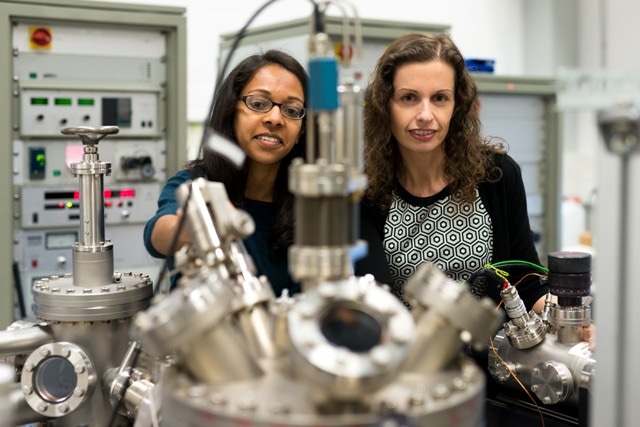Jul 5 2016
Though the prospect of converting greenhouse gas carbon dioxide into an effective chemical is highly desirable, the catalysts available are not enough to make this possible.
 Researching new catalysts that convert carbon dioxide: Hemma Mistry (on the left) and Beatriz Roldan Cuenya. (Credit: RUB, Kramer)
Researching new catalysts that convert carbon dioxide: Hemma Mistry (on the left) and Beatriz Roldan Cuenya. (Credit: RUB, Kramer)
A remedy for this has been developed by researchers who have successfully found a catalyst that can convert carbon dioxide to ethylene, an essential raw material of the chemical industry. The process of using plasma-treated copper for this purpose has been explained in Nature Communications by a team from Ruhr-Universität Bochum, headed by Prof Dr Beatriz Roldan Cuenya.
Conventionally most of the catalysts used for converting carbon dioxide into other useable chemicals were not very efficient. These catalysts lack the selectivity required and generate too many unwanted products and less quantities of ethylene. Currently, this scenario has been changed.
More Selectivity through Plasma Treatment
Hemma Mistry is a PhD student at the Institute for Experimental Physics IV, situated in Bochum. She made use of copper films as catalysts, after treating them with hydrogen or oxygen plasmas. The plasma treatment oxidized the copper and helped change its surface properties such as roughness. Mistry made calculated changes to the plasma parameters in order to find the optimal surface properties.
The ideal catalyst thus created was able to generate more ethylene than by other conventional copper catalysts. The catalyst also shows high rates of selectivity which results in reduced production of unnecessary side products. “It’s a new record for this material,” states Beatriz Roldan Cuenya.
Mechanism Decoded
The reason behind the success of this particular plasma has also been discovered by the researchers. During the period of catalysis, the researchers used synchrotron radiation to study the copper film at its chemical form. The finding of the study identified the positively charged copper ions on the surface of the catalyst as the major reason behind its high selectivity.
The research has broken the belief that copper is capable of existing only in the metallic state during the reaction period. Further microscopic analysis has verified the results of the study.
The results open up new possibilities for designing catalysts on the nanoscale with specific activity and selectivity.
Beatriz Roldan Cuenya.
Cooperation Partners
The team from Ruhr-Universität Bochum collaborated with three other groups from Technische Universität Berlin, University of Pittsburgh and Brookhaven National Laboratory headed by Prof Dr Peter Strasser, Prof Dr Judith C. Yang and Dr Eric A. Stach, respectively. Facilities at Stanford Synchrotron Radiation Lightsource were also used for the research process.
Funding
The study was funded by US National Science Foundation (NSF-Chemistry 1213182 and NSF-DMR 1207065, the Office for Basic Energy Sciences at the US Department of Energy (DE-FG02-08ER15995), the German Research Foundation under the umbrella of the Cluster of Excellence RESOLV (EXC 1069) and the Federal Ministry of Education and Research (#03SF0523, CO2EKAT).
Source: http://www.ruhr-uni-bochum.de/